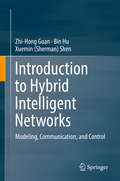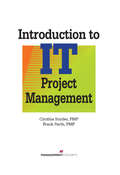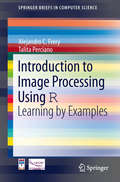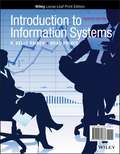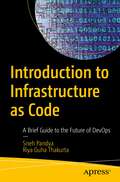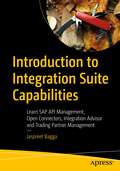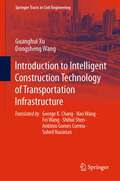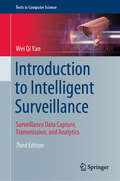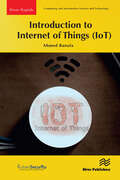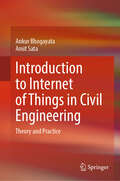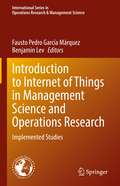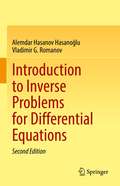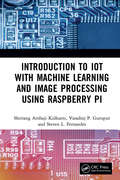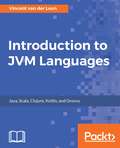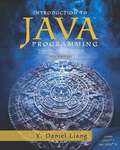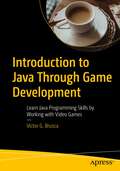- Table View
- List View
Introduction to High Performance Computing for Scientists and Engineers (Chapman & Hall/CRC Computational Science)
by Georg Hager Gerhard WelleinWritten by high performance computing (HPC) experts, Introduction to High Performance Computing for Scientists and Engineers provides a solid introduction to current mainstream computer architecture, dominant parallel programming models, and useful optimization strategies for scientific HPC. From working in a scientific computing center, the author
Introduction to High-Dimensional Statistics (Chapman & Hall/CRC Monographs on Statistics and Applied Probability #138)
by Christophe GiraudPraise for the first edition: "[This book] succeeds singularly at providing a structured introduction to this active field of research. … it is arguably the most accessible overview yet published of the mathematical ideas and principles that one needs to master to enter the field of high-dimensional statistics. … recommended to anyone interested in the main results of current research in high-dimensional statistics as well as anyone interested in acquiring the core mathematical skills to enter this area of research."—Journal of the American Statistical Association Introduction to High-Dimensional Statistics, Second Edition preserves the philosophy of the first edition: to be a concise guide for students and researchers discovering the area and interested in the mathematics involved. The main concepts and ideas are presented in simple settings, avoiding thereby unessential technicalities. High-dimensional statistics is a fast-evolving field, and much progress has been made on a large variety of topics, providing new insights and methods. Offering a succinct presentation of the mathematical foundations of high-dimensional statistics, this new edition: Offers revised chapters from the previous edition, with the inclusion of many additional materials on some important topics, including compress sensing, estimation with convex constraints, the slope estimator, simultaneously low-rank and row-sparse linear regression, or aggregation of a continuous set of estimators. Introduces three new chapters on iterative algorithms, clustering, and minimax lower bounds. Provides enhanced appendices, minimax lower-bounds mainly with the addition of the Davis-Kahan perturbation bound and of two simple versions of the Hanson-Wright concentration inequality. Covers cutting-edge statistical methods including model selection, sparsity and the Lasso, iterative hard thresholding, aggregation, support vector machines, and learning theory. Provides detailed exercises at the end of every chapter with collaborative solutions on a wiki site. Illustrates concepts with simple but clear practical examples.
Introduction to Hybrid Intelligent Networks: Modeling, Communication, and Control
by Bin Hu Xuemin Sherman Shen Zhi-Hong GuanThis book covers the fundamental principles, new theories and methodologies, and potential applications of hybrid intelligent networks. Chapters focus on hybrid neural networks and networked multi-agent networks, including their communication, control and optimization synthesis. This text also provides a succinct but useful guideline for designing neural network-based hybrid artificial intelligence for brain-inspired computation systems and applications in the Internet of Things.Artificial Intelligence has developed into a deep research field targeting robots with more brain-inspired perception, learning, decision-making abilities, etc. This text devoted to a tutorial on hybrid intelligent networks that have been identified in nature and engineering, especially in the brain, modeled by hybrid dynamical systems and complex networks, and have shown potential application to brain-inspired intelligence. Included in this text are impulsive neural networks, neurodynamics, multiagent networks, hybrid dynamics analysis, collective dynamics, as well as hybrid communication, control and optimization methods. Graduate students who are interested in artificial intelligence and hybrid intelligence, as well as professors and graduate students who are interested in neural networks and multiagent networks will find this textbook a valuable resource. AI engineers and consultants who are working in wireless communications and networking will want to buy this book. Also, professional and academic institutions in universities and Mobile vehicle companies and engineers and managers who concern humans in the loop of IoT will also be interested in this book.
Introduction to IT Project Management
by Cynthia Snyder PMP Frank Parth PMPIntroduction to IT Project Management provides IT project managers the practical tools needed to maintain daily operations while managing multiple projects. This valuable reference helps IT project managers, CIOs, and project sponsors understand the IT project environment so that projects can be managed much more efficiently and successfully. An instructor's guide is available.
Introduction to Image Processing Using R
by Alejandro C. Frery Talita PercianoThis book introduces the statistical software R to the image processing community in an intuitive and practical manner. R brings interesting statistical and graphical tools which are important and necessary for image processing techniques. Furthermore, it has been proved in the literature that R is among the most reliable, accurate and portable statistical software available. Both the theory and practice of R code concepts and techniques are presented and explained, and the reader is encouraged to try their own implementation to develop faster, optimized programs. Those who are new to the field of image processing and to R software will find this work a useful introduction. By reading the book alongside an active R session, the reader will experience an exciting journey of learning and programming.
Introduction to Image Processing and Analysis
by John C. Russ J. Christian Russ<p>Image processing comprises a broad variety of methods that operate on images to produce another image. A unique textbook, Introduction to Image Processing and Analysis establishes the programming involved in image processing and analysis by utilizing skills in C compiler and both Windows and MacOS programming environments. The provided mathematical background illustrates the workings of algorithms and emphasizes the practical reasons for using certain methods, their effects on images, and their appropriate applications. The text concentrates on image processing and measurement and details the implementation of many of the most widely used and most important image processing and analysis algorithms. <p>Homework problems are included in every chapter with solutions available for download from the CRC Press website. The chapters work together to combine image processing with image analysis. The book begins with an explanation of familiar pixel array and goes on to describe the use of frequency space. Chapters 1 and 2 deal with the algorithms used in processing steps that are usually accomplished by a combination of measurement and processing operations, as described in chapters 3 and 4. The authors present each concept using a mixture of three mutually supportive tools: a description of the procedure with example images, the relevant mathematical equations behind each concept, and the simple source code (in C), which illustrates basic operations. In particularly, the source code provides a starting point to develop further modifications. <p>Written by John Russ, author of esteemed Image Processing Handbook now in its fifth edition, this book demonstrates functions to improve an image's of features and detail visibility, improve images for printing or transmission, and facilitate subsequent analysis.</p>
Introduction to Industrial Internet of Things and Industry 4.0
by Sudip Misra Chandana Roy Anandarup MukherjeeIndustrial IoT (IIoT) and Industry 4.0 are newly developing and fast emerging domains of interest among students, researchers, and professionals in academia and industry. Due to the popular demand of this topic, Introduction to Industrial Internet of Things and Industry 4.0 is written to serve a diverse readership from the domains of computer science and engineering, mechanical engineering, information technology, industrial engineering, electronics engineering, and other related branches of engineering. Based on the lead author’s massive open online courses (MOOCs), this book can be used as a textbook on the emerging paradigm of Industry 4.0 and IIoT, as well as a reference for professionals working in sectors of IIoT. The book covers the significant aspects of IIoT in detail, including sensors, actuators, data transmission, and data acquisition, which form the core of IIoT. Topics and concepts are presented in a comprehensive manner, so that readers can develop expertise and knowledge. The book helps beginners to gain a basic idea of Industry 4.0 and IIoT as the first section is an overview of IoT applications, infrastructure-based protocols, cloud computing, and fog computing. The second section is designed to impart a basic knowledge of Industry 4.0 and IIoT as well as of the different phases of development in industry. Delving into more advanced areas, other sections in the book cover: The business models and reference architecture of IIoT The technological aspects of Industry 4.0 and IIoT Predictive and prescriptive analytics applied in IIoT-based implementations Applications and case studies of IIoT Key enabling technologies of IIoT To aid students and professional master IIoT and Industry 4.0, the book includes conceptual questions, exercises, and learning objectives.
Introduction to Information Retrieval
by Christopher D. Manning Prabhakar Raghavan Hinrich SchützeClass-tested and coherent, this groundbreaking new textbook teaches web-era information retrieval, including web search and the related areas of text classification and text clustering from basic concepts. Written from a computer science perspective by three leading experts in the field, it gives an up-to-date treatment of all aspects of the design and implementation of systems for gathering, indexing, and searching documents; methods for evaluating systems; and an introduction to the use of machine learning methods on text collections. All the important ideas are explained using examples and figures, making it perfect for introductory courses in information retrieval for advanced undergraduates and graduate students in computer science. Based on feedback from extensive classroom experience, the book has been carefully structured in order to make teaching more natural and effective. Although originally designed as the primary text for a graduate or advanced undergraduate course in information retrieval, the book will also create a buzz for researchers and professionals alike.
Introduction to Information Systems (14th edition)
by James A. O'Brien George M. MarakasO'Brien's Introduction to Information Systems 14e continues to reflect the movement toward enterprise-wide business applications. George Marakas from the University of Kansas joins as a co-author on this new edition. New real world case studies correspond with this curriculum shift. The texts focus is on teaching the general business manager how to use and manage the most current IT technologies such as the Internet, Intranets, and Extranets for enterprise collaboration, and how IT contributes to competitive advantage, re-engineering business processes, problem solving, and decision-making.
Introduction to Information Systems for Health Information Technology
by Nanette B. Sayles Lauralyn Kavanaugh-BurkeIntroduction to Computers in Health, Information Management, Information Integrity and Data Quality, Databases System Selection, System Implementation Computers in HIM, Administrative Information Systems, Clinical Information Systems, Electronic Health Record, Consumer Informatics, Health Information Exchange, Standards, Security, Information and Data Governance, Role of HIM, Professionals in Information Systems.
Introduction to Information Systems: Seventh Edition
by R. Kelly Rainer Casey G. CegielskiThe goal of Introduction to Information Systems is to teach undergraduate business majors how to use information technology to master their current or future jobs. Students develop a working understanding of information systems and information technology and learn how to apply concepts to successfully facilitate business processes. This product demonstrates that IT is a key component of any business, whether a student is majoring in Accounting, Finance, Marketing, Human Resources, or Production/Operations Management.
Introduction to Information Theory and Data Compression (Applied Mathematics)
by Peter D. Johnson Jr. Greg A. Harris D.C. HankersonAn effective blend of carefully explained theory and practical applications, this text imparts the fundamentals of both information theory and data compression. Although the two topics are related, this unique text allows either topic to be presented independently, and it was specifically designed so that the data compression section requires no pr
Introduction to Infrastructure as Code: A Brief Guide to the Future of DevOps
by Sneh Pandya Riya Guha ThakurtaGet inspired to explore the depths of the DevOps field. In today’s rapidly transforming world, Infrastructure as Code (IaC) has emerged as an effective approach to maintain, scale, and deploy software systems. This book offers a mixture of foundational IaC concepts and practical examples to give you hands-on experience.You will first gain an understanding of DevOps culture as well as how to adapt to IaC. Introduction to Infrastructure as Code begins by reviewing the innovative features that DevOps in general, and IaC in particular, have to offer for adoption and growth for different verticals. With this solid base established, you will then learn the importance, processes, and outcome of building infrastructure solutions.Authors Sneh Pandya and Riya Guha Thakurta then provide hands-on examples utilizing IaC platforms, open source tools, and essential considerations such as security, scalability, and deployments. Each chapter focuses on one vertical (i.e., foundations, architecture patterns, securing infrastructure, preparing for deployment), how it impacts the DevOps toolchain in a holistic manner, and how it can be used to build solutions specific to that vertical, with a detailed walkthrough of code, environments, and other tools. After completing this book, you’ll have launched your own infrastructure solution through an open source stack consisting of platforms and tools such as Terraform, Chef, and Puppet.What You Will LearnUnderstand the fundamentals of DevOps and Infrastructure as CodePrepare for the ever-evolving ecosystem of modular infrastructure and the needs of the futureAvoid potential pitfalls and breakdowns while working with infrastructureBuild scalable and efficient IaC solutions that work at a small, medium, and large scale in a real-life environmentUnderstand and be responsibly aware of security concerns related to the domain, and how to address themWho Is This Book ForBeginners interested in building a career in DevOps as well as professionals looking to gain expertise and advance their career with greater knowledge of IaC. including Technical Product Managers, and Architects.
Introduction to Integration Suite Capabilities: Learn SAP API Management, Open Connectors, Integration Advisor and Trading Partner Management
by Jaspreet BaggaDiscover the power of SAP Integration Suite's capabilities with this hands-on guide. Learn how this integration platform (iPaaS) can help you connect and automate your business processes with integrations, connectors, APIs, and best practices for a faster ROI. Over the course of this book, you will explore the powerful capabilities of SAP Integration Suite, including API Management, Open Connectors, Integration Advisor, Trading Partner Management, Migration Assessment, and Integration Assessment. With detailed explanations and real-world examples, this book is the perfect resource for anyone looking to unlock the full potential of SAP Integration Suite. With each chapter, you'll gain a greater understanding of why SAP Integration Suite can be the proverbial swiss army knife in your toolkit to design and develop enterprise integration scenarios, offering simplified integration, security, and governance for your applications. Author Jaspreet Bagga demonstrates how to create, publish, and monitor APIs with SAP API Management, and how to use its features to enhance your API lifecycle. He also provides a detailed walkthrough of how other capabilities of SAP Integration Suite can streamline your connectivity, design, development, and architecture methodology with a tool-based approach completely managed by SAP. Whether you are a developer, an architect, or a business user, this book will help you unlock the potential of SAP's Integration Suite platform, API Management, and accelerate your digital transformation. What You Will Learn Understand what APIs are, what they are used for, and why they are crucial for building effective and reliable applicationsGain an understanding of SAP Integration Suite's features and benefits Study SAP Integration assessment process, patterns, and much moreExplore tools and capabilities other than the Cloud Integration that address the full value chain of the enterprise integration components Who This Book Is For Web developers and application leads who want to learn SAP API Management.
Introduction to Intelligent Construction Technology of Transportation Infrastructure (Springer Tracts in Civil Engineering)
by Dongsheng Wang Guanghui XuThis book expounds on the related technologies of intelligent transportation infrastructure construction. Based on the essential characteristics of intelligent construction, "perception, analysis, decision-making, and execution," the basic structure of intelligent construction technology (ICT) is established. With the integration of engineering construction technologies, the analyses of the essence of intelligent algorithms and the feasibility of Artificial Intelligence (AI) are provided. The book introduces the essential characteristics of Big Data and the Internet of Things and their relationship with engineering construction. On this basis, the feasibility and implementation plan of intelligent technology applications in design, construction, and maintenance are analyzed and demonstrated with engineering examples. The book also combines ICT with intelligent construction talent training, the professional knowledge required for intelligent construction, and the theoretical basis to provide the methods for mastering new technologies. This book can be used by technical personnel in related fields such as highways, railways, airports, and urban road construction to understand and master innovative, intelligent construction technologies. It can also be a reference book for ICT-related college courses.
Introduction to Intelligent Surveillance: Surveillance Data Capture, Transmission, and Analytics (Texts in Computer Science)
by Wei Qi YanThis practically-oriented textbook introduces the fundamentals of designing digital surveillance systems powered by intelligent computing techniques. The text offers comprehensive coverage of each aspect of the system, from camera calibration and data capture, to the secure transmission of surveillance data, in addition to the detection and recognition of individual biometric features and objects. The coverage concludes with the development of a complete system for the automated observation of the full lifecycle of a surveillance event, enhanced by the use of artificial intelligence and supercomputing technology.This updated third edition presents an expanded focus on human behavior analysis and privacy preservation, as well as deep learning methods.Topics and features: contains review questions and exercises in every chapter, together with a glossary; describes the essentials of implementing an intelligent surveillance system and analyzing surveillance data, including a range of biometric characteristics; examines the importance of network security and digital forensics in the communication of surveillance data, as well as issues of issues of privacy and ethics; discusses the Viola-Jones object detection method, and the HOG algorithm for pedestrian and human behavior recognition; reviews the use of artificial intelligence for automated monitoring of surveillance events, and decision-making approaches to determine the need for human intervention; presents a case study on a system that triggers an alarm when a vehicle fails to stop at a red light, and identifies the vehicle’s license plate number; investigates the use of cutting-edge supercomputing technologies for digital surveillance, such as FPGA, GPU and parallel computing.This concise and accessible work serves as a classroom-tested textbook for graduate-level courses on intelligent surveillance. Researchers and engineers interested in entering this area will also find the book suitable as a helpful self-study reference.
Introduction to Interactive Digital Media: Concept and Practice
by Julia V. GriffeyThis book offers a clearly written and engaging introduction to the basics of interactive digital media. As our reliance on and daily usage of websites, mobile apps, kiosks, games, VR/AR and devices that respond to our commands has increased, the need for practitioners who understand these technologies is growing. Author Julia Griffey provides a valuable guide to the fundamentals of this field, offering best practices and common pitfalls throughout. The book also notes opportunities within the field of interactive digital media for professionals with different types of skills, and interviews with experienced practitioners offer practical wisdom for readers. Additional features of this book include: An overview of the history, evolution and impact of interactive media; A spotlight on the development process and contributing team members; Analysis of the components of interactive digital media and their design function (graphics, animation, audio, video, typography, color); An introduction to coding languages for interactive media; and A guide to usability in interactive media. Introduction to Interactive Digital Media will help both students and professionals understand the varied creative, technical, and collaborative skills needed in this exciting and emerging field.
Introduction to Internet of Things (River Publishers Series in Rapids in Computing and Information Science and Technology)
by Ahmed BanafaThis book introduces the Internet of Things (IoT), which is the convergence of connecting people, things, data and processes; it is transforming our life, business and everything in between. By 2025, experts forecast that up to 75 billion devices will be connected to the Internet with only one third of them being computers, smartphones, smartwatches, and tablets. The remaining two thirds will be other "devices" – sensors, terminals, household appliances, thermostats, televisions, automobiles, production machinery, urban infrastructure and many other "things", which traditionally have not been Internet enabled. This "Internet of Things" (IoT) represents a remarkable transformation of the way in which our world will soon interact. Much like the World Wide Web connected computers to networks, and the next evolution mobile devices connected people to the Internet and other people, IoT looks poised to interconnect devices, people, environments, virtual objects and machines in ways that only science fiction writers could have imagined.
Introduction to Internet of Things in Civil Engineering: Theory and Practice
by Ankur Bhogayata Amit SataThis textbook provides introductory concepts of the Internet of Things (IoT) in a concise and clear format. It presents in-depth information on the technological transformations and attributes of IoT. It also presents various examples of the applications of IoT in the field of civil engineering, both in laboratories and in the field. Various self-explanatory illustrations, figures, photographs and numerical details are included for a better understanding of concepts. A summary of contents and a list of review questions are provided at the end of each section for self-evaluation of the learnings from each chapter. A dedicated chapter for teachers is also provided which discusses pedagogy and curriculum development for the emerging field of IoT with reference to civil engineering education. The book also suggests methods of utilisation and integration of IoT concepts in education through assignments, tutorials, project works and research topics. This book is a valuable learning resource for undergraduate civil engineering students with limited exposure to computer science and engineering. It also functions as a reference resource for postgraduate students and scholars dealing with the application of IoT in civil engineering.
Introduction to Internet of Things in Management Science and Operations Research: Implemented Studies (International Series in Operations Research & Management Science #311)
by Fausto Pedro García Márquez Benjamin LevThis book aims to provide relevant theoretical frameworks and the latest empirical research findings in Internet of Things (IoT) in Management Science and Operations Research. It starts with basic concept and present cases, applications, theory, and potential future. The contributed chapters to the book cover wide array of topics as space permits. Examples are from smart industry; city; transportation; home and smart devices. They present future applications, trends, and potential future of this new discipline. Specifically, this book provides an interface between the main disciplines of engineering/technology and the organizational, administrative, and planning capabilities of managing IoT. This book deals with the implementation of latest IoT research findings in practice at the global economy level, at networks and organizations, at teams and work groups and, finally, IoT at the level of players in the networked environments. This book is intended for professionals in the field of engineering, information science, mathematics, economics, and researchers who wish to develop new skills in IoT, or who employ the IoT discipline as part of their work. It will improve their understanding of the strategic role of IoT at various levels of the information and knowledge organization. The book is complemented by a second volume of the same editors with practical cases.
Introduction to Inverse Problems for Differential Equations
by Vladimir G. Romanov Alemdar Hasanov HasanoğluThis book presents a systematic exposition of the main ideas and methods in treating inverse problems for PDEs arising in basic mathematical models, though it makes no claim to being exhaustive. Mathematical models of most physical phenomena are governed by initial and boundary value problems for PDEs, and inverse problems governed by these equations arise naturally in nearly all branches of science and engineering.The book’s content, especially in the Introduction and Part I, is self-contained and is intended to also be accessible for beginning graduate students, whose mathematical background includes only basic courses in advanced calculus, PDEs and functional analysis. Further, the book can be used as the backbone for a lecture course on inverse and ill-posed problems for partial differential equations.In turn, the second part of the book consists of six nearly-independent chapters. The choice of these chapters was motivated by the fact that the inverse coefficient and source problems considered here are based on the basic and commonly used mathematical models governed by PDEs. These chapters describe not only these inverse problems, but also main inversion methods and techniques. Since the most distinctive features of any inverse problems related to PDEs are hidden in the properties of the corresponding solutions to direct problems, special attention is paid to the investigation of these properties.For the second edition, the authors have added two new chapters focusing on real-world applications of inverse problems arising in wave and vibration phenomena. They have also revised the whole text of the first edition.
Introduction to IoT with Machine Learning and Image Processing using Raspberry Pi
by Shrirang Ambaji Kulkarni Varadrah P. Gurupur Steven L. FernandesMachine Learning a branch of Artificial Intelligence is influencing the society, industry and academia at large. The adaptability of Python programming language to Machine Learning has increased its popularity further. Another technology on the horizon is Internet of Things (IoT). The present book tries to address IoT, Python and Machine Learning along with a small introduction to Image Processing. If you are a novice programmer or have just started exploring IoT or Machine Learning with Python, then this book is for you. Features: Raspberry Pi as IoT is described along with the procedure for installation and configuration. A simple introduction to Python Programming Language along with its popular library packages like NumPy, Pandas, SciPy and Matplotlib are dealt in an exhaustive manner along with relevant examples. Machine Learning along with Python Scikit-Learn library is explained to audience with an emphasis on supervised learning and classification. Image processing on IoT is introduced to the audience who love to apply Machine Learning algorithms to Images The book follows hands-on approach and provide a huge collection of Python programs.
Introduction to JVM Languages
by Vincent Van LeunExplore the Java Virtual Machine with modern programming languages About This Book • This guide provides in-depth coverage of the Java Virtual Machine and its features • Filled with practical examples, this book will help you understand the core concepts of Java, Scala, Clojure, Kotlin, and Groovy • Work with various programming paradigms and gain knowledge about imperative, object-oriented and functional programming Who This Book Is For This book is meant for programmers who are interested in the Java Virtual Machine (JVM) and want to learn more about the most popular programming languages that can be used for JVM development. Basic practical knowledge of a modern programming language that supports object-oriented programming (JavaScript, Python, C#, VB.NET, and C++) is assumed. What You Will Learn • Gain practical information about the Java Virtual Machine • Understand the popular JVM languages and the Java Class Library • Get to know about various programming paradigms such as imperative, object-oriented, and functional • Work with common JVM tools such as Eclipse IDE, Gradle, and Maven • Explore frameworks such as SparkJava, Vert.x, Akka and JavaFX • Boost your knowledge about dialects of other well-known programming languages that run on the JVM, including JavaScript, Python, and Ruby In Detail Anyone who knows software development knows about the Java Virtual Machine. The Java Virtual Machine is responsible for interpreting Java byte code and translating it into actions. In the beginning, Java was the only programming language used for the JVM. But increasing complexity of the language and the remarkable performance of the JVM created an opening for a new generation of programming languages. If you want to build a strong foundation with the Java Virtual Machine and get started with popular modern programming languages, then this book is for you. The book will begin with a general introduction of the JVM and its features, which are common to the JVM languages, helping you get abreast with its concepts. It will then dive into explaining languages such as Java, Scala, Clojure, Kotlin, and Groovy and will show how to work with each language, their features, use cases, and pros and cons. By writing example projects in those languages and focusing on each language's strong points, it will help you find the programming language that is most appropriate for your particular needs. By the end of the book, you will have written multiple programs that run on the Java Virtual Machine and know about the differences between the various languages. Style and approach This practical, example-filled guide will help you get started with the JVM and some of its most popular languages.
Introduction to Java Programming, Comprehensive Version
by Y. Daniel LiangThis text is intended for a 1-, 2-, or 3-semester CS1 course sequence. Comprehensive coverage of Java and programming make this a useful reference for beginning programmers and IT professionals. Daniel Liang teaches concepts of problem-solving and object-oriented programming using a fundamentals-first approach. Beginning programmers learn critical problem-solving techniques then move on to grasp the key concepts of object-oriented, GUI programming, advanced GUI and Web programming using Java. Liang approaches Java GUI programming using JavaFX, not only because JavaFX is much simpler for new Java programmers to learn and use but because it has replaced Swing as the new GUI tool for developing cross-platform-rich Internet applications on desktop computers, on hand-held devices, and on the Web.
Introduction to Java Through Game Development: Learn Java Programming Skills by Working with Video Games
by Victor G. BruscaInterested in learning how to program with Java? Let’s face it, the best way to learn to program is by writing programs. This can be a daunting proposition with the specter of hours of simple command line example programs hanging over your head. Fear not! Now you can learn to program in Java in a fun way by working on video games. With this book, you’ll get to work with three Java game projects and have access to the complete game code for each project, including a full Java game engine. After completing Introduction to Java through Game Development, you’ll be proficient in Java programming, having worked with the language’s fundamental aspects throughout the text, and will be ready to further your Java and game programming expertise with confidence.What You'llMaster the fundamentals of the Java programming languageUse different data structures like arrays, lists, stacks, and queuesUnderstand game programming basics including the main game loopGain experience working with three different game projects via the book’s coding challengesWork with the 2D game engine that powers the book's included games and learn to create your own new game projectsUnderstand advanced Java topics like classes, encapsulation, inheritance, and polymorphismWork with exceptions and how to use debugging techniques to trace through codeSharpen your skills with over a dozen coding challenges that test your abilities with a development task on a real game projectWho This Book Is ForThis book requires little to no programming experience to understand and benefit from the text.


